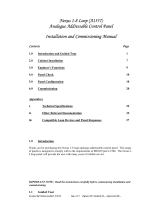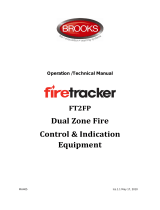Page is loading ...

Issue 1.1
A1536 8 Way Alarm Board
for Premier AL
Application, Installation and
Commissioning Manual
Contents
Page
1
.
Introduction and Guided Tour 1
2. Node Addressing Details 2
3. Installation Instructions 3
4. Commissioning 4
Up to 31 A1536 (alarm) [and/or A1535 relay] programmable expansion
boards may be connected to the Nexus 1-8 loop panel. The A1536 board
provides 8 programmable inputs (0V switched) and 8 programmable alarm
circuit outputs.
A 1619 Interface board has to be fitted to the Motherboard of
the Premier AL , for I/O Boards to communicate and be used with the
Premier AL

Issue 1.1
1.1 A Guided Tour
1.1.1 A1536 8 Way Programmable Input/Output Relay Board
Common fault
Relay Output
A B SCN
MX - MX + NOT USED
I/O BOARD RAIL IN PREMIER AL

Issue 1.1
2.0 Node Addressing Details
Set the required board address on switches SW1, according to the table
below:
Node
Address
Bit 4
Bit 3
Bit 2
Bit 1
Bit 0
I/O Circuits
1 Off Off Off Off On 1 to 8
2 Off Off Off On Off 9 to 16
3 Off Off Off On On 17 to 24
4 Off Off On Off
Off 25 to 32
5 Off Off On Off
On 33 to 40
6 Off Off On On Off 41 to 48
7 Off Off On On On 49 to 56
8 Off On Off Off Off 57 to 64
9 Off On Off Off On 65 to 72
10 Off On Off On Off 73 to 80
11 Off On Off On On 81 to 88
12 Off On On Off Off 89 to 96
13 Off On On Off On 97 to 104
14 Off On On On Off 105 to 112
15 Off On On On On 113 to 120
16 On Off Off Off Off 121 to 128
17 On Off
Off Off On 129 to 136
18 On Off
Off On Off 137 to 144
19 On Off
Off On On 145 to 152
20 On Off On Off
Off 153 to 160
21 On Off On Off
On 161 to 168
22 On Off
On On Off 169 to 176
23 On Off On On On 177 to 184
24 On On Off Off Off 185 to 192
25 On On Off Off On 193 to 200
26 On On Off On Off 201 to 208
27 On On Off On On 209 to 216
28 On On On Off Off 217 to 224
29 On On On Off On 225 to 232
30 On On On On Off 233 to 240
31 On On On On On 241 to 248
3.0 Installation Instructions
3.1 Connect MX+ and MX-from the A1536 alarm board to the
control panel motherboard (terminals I/O) observing
correct polarity at both ends.
3.2 Connect 24V and 0V supplies from the A1536 alarm board to

Issue 1.1
the power supply unit. This can either be an auxiliary
power supply or the control panel’s power supply.
NOTE: If an auxiliary power supply is used, then the open collector
fault output on the power supply should be connected to the power
supply fault monitor input terminals on the panel motherboard.
WARNING: Do not apply power at this stage.
3.3
Connect the alarm circuit field wiring, observing alarm
polarity, and ensuring that
each output is terminated with a 3K9 resistor across the last
sounder’s terminals. This resistor is used in the monitoring of
open and short circuit conditions. Reverse polarity monitoring is
used, therefore all devices should be polarised and suppressed.
The alarm circuit terminals are marked with “Alarm Polarity”.
NOTE: If any alarm output remains unused, it is necessary that it is
terminated with a
3K9
resistor.
3.4
Connect the field wiring for all required inputs to the A1536
board.
NOTE: The inputs on this board are active when switched to 0V.
4.0 Commissioning
4.1
Ensure that the Test Alarms DIL switch option is switched off
and that the remote Test Alarms input is non-active.
4.2
Disconnect MX+ at the A1536 alarm board and then apply power to
the board. Any short or open circuit problems with the alarm
circuits will be displayed as an alarm output fault on the eight
alarm fault LEDs. These problems should be traced and
corrected before reconnection to the panel. The COMMS. FAILED
LED will light during this testing; this should be ignored.
4.3
The next task is to programme the panel to accept the A1536
alarm board. This is done in the EDIT C/E Data option on the
Premier AL panel (Option 9 in the extended menu). The two
valid board types for the A1536 are:
Type 1: ALARM (N-MON) Inputs 8 non-latching, non-monitored
indication only (ie non fire or fault
reporting) inputs which can be used within
the panel’s cause/effect facility. Outputs
8 alarm circuits, programmable with the
panel’s cause/effect facility.
Type 5: ALARM (FIRE) Inputs 8 latching, non-monitored fire
indicating inputs which can be used within
the panel’s cause/effect facility.
NOTE: Not suitable for connection to

Issue 1.1
detectors.
Outputs 8 alarm circuits, programmable
with the panel’s cause/effect facility.
4.4
The next step is to programme the desired cause and effect for
the inputs and outputs on the A1536 board. The outputs are
programmed using the PANEL OUTPUTS option in the EDIT C/E DATA
extended menu
option.

Issue 1.1

Issue 1.1
l. The inputs are allocated to zones in the ZONE
ALLOCATION option. Cause and effect programming can then be
written using these zones.

Issue 1.1

Issue 1.1
Appendices
i Technical Specifications
Device A1536 Alarm Board
Addressing : 1 to 31 using DIL switches
Communications protocol : RS485
Supply voltage : 24V DC
Quiescent current : 100mA
Alarm mode current : 100mA + 25mA per active alarm output
+ alarm current (when operational)
Maximum supply current : 9A
Alarm circuit current : 8 x fully loaded alarm outputs,each at 1A
/


